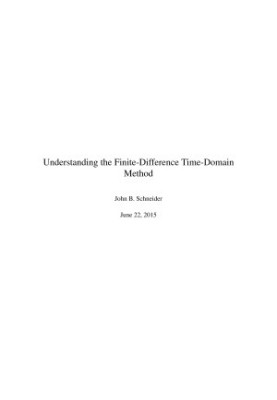Understanding the Finite-Difference Time-Domain Method
 Моментальне завантаження
Моментальне завантаження
після оплати (24/7)
 Широкий вибір форматів
Широкий вибір форматів
(для всіх пристроїв)
 Повна версія книги
Повна версія книги
(в т.ч. для Apple та Android)
Washington State University, 2015. - 403 pp.Книга основана на курсе лекций, которые автор читал в School of Electrical Engineering and Computer Science Washington State University. Курс посвящен изложению метода конечных разностей во временно́й области (англ. Finite Difference Time Domain, FDTD) — одному из наиболее популярных методов численной электродинамики, основанному на дискретизации уравнений Максвелла, записанных в дифференциальной форме.Метод конечных разностей является основным для моделирования самых разных радиоволновых и оптических приложений. Он с успехом применяется для решения широкого спектра задач: от моделирования сверхдлинных электромагнитных волн и микроволн (например для изучения сигнатурной радиолокации, расчёта характеристик антенн, разработки беспроводных устройств связи, в том числе цифровых) до решения задач в оптическом диапазоне (фотонные кристаллы, наноплазмоника, солитоны и биофотоника).В настоящее время существует порядка 30 коммерческих программ FDTD, а также проекты с открытым исходным кодом.Цель этой книги - дать читателю объем знаний, необходимый для написания быстрого и эффективного кода, реализующего FDTD, на языке Си. В книге изложены основы электродинамики, теоретические основы FDTD, алгоритмы двухмерного и трехмерного FDTD, способы программной оптимизации на основе распараллеливания вычислений и многопоточности. Изложение сопровождается примерами программных блоков на языке Си.СодержаниеA simple overview of some of the errors inherent in digital computation.IntroductionFinite PrecisionSymbolic ManipulationBrief Review of Electromagnetics.IntroductionCoulomb’s Law and Electric FieldElectric Flux DensityStatic Electric FieldsGradient, Divergence, and CurlLaplacianGauss’s and Stokes’ TheoremsElectric Field Boundary ConditionsConductivity and Perfect Electric ConductorsMagnetic FieldsMagnetic Field Boundary ConditionsSummary of Static FieldsTime Varying FieldsSummary of Time-Varying FieldsWave Equation in a Source-Free RegionOne-Dimensional Solutions to the Wave EquationIntroduction to the Finite-Difference Time-Domain Method: FDTD in 1D.IntroductionThe Yee AlgorithmUpdate Equations in 1DComputer Implementation of a One-Dimensional FDTD SimulationBare-Bones SimulationPMC Boundary in One DimensionSnapshots of the FieldAdditive SourceTerminating the GridTotal-Field/Scattered-Field BoundaryInhomogeneitiesLossy MaterialImproving the FDTD Code.IntroductionArrays and Dynamic Memory AllocationMacrosStructuresImprovement Number OneModular Design and Initialization FunctionsImprovement Number TwoCompiling Modular CodeImprovement Number ThreeScaling FDTD Simulations to Any Frequency.IntroductionSourcesGaussian PulseHarmonic SourcesThe Ricker WaveletMapping Frequencies to Discrete Fourier TransformsRunning Discrete Fourier Transform (DFT)Real Signals and DFT’sAmplitude and Phase from Two Time-Domain SamplesConductivityTransmission Coefficient for a Planar InterfaceTransmission through Planar InterfaceMeasuring the Transmission Coefficient Using FDTDIntroductionThe Advection EquationTerminating the GridImplementation of a First-Order ABCABC Expressed Using Operator NotationSecond-Order ABCImplementation of a Second-Order ABCDispersion, Impedance, Reflection, and Transmission.IntroductionDispersion in the Continuous WorldHarmonic Representation of the FDTD MethodDispersion in the FDTD GridNumeric ImpedanceAnalytic FDTD Reflection and Transmission CoefficientsReflection from a PECInterface Aligned with an Electric-Field NodeTwo-Dimensional FDTD Simulations.IntroductionMultidimensional ArraysTwo Dimensions: TMz PolarizationTMz ExampleThe TFSF Boundary for TMz PolarizationTMz TFSF Boundary ExampleTEz PolarizationPEC’s in TEz and TMz SimulationsTEz ExampleThree-Dimensional FDTD.Introduction3D Arrays in CGoverning Equations and the 3D Grid3D ExampleTFSF BoundaryTFSF DemonstrationUnequal Spatial StepsDispersive Material.IntroductionConstitutive Relations and Dispersive MediaDrude MaterialsLorentz MaterialDebye MaterialDebye Materials Using the ADE MethodDrude Materials Using the ADE MethodMagnetically Dispersive MaterialPiecewise Linear Recursive ConvolutionPLRC for Debye MaterialPerfectly Matched Layer.IntroductionLossy Layer, 1DLossy Layer, 2DSplit-Field Perfectly Matched LayerUn-Split PMLFDTD Implementation of Un-Split PMLAcoustic FDTD Simulations.IntroductionGoverning FDTD EquationsTwo-Dimensional ImplementationParallel Processing.ThreadsThread ExamplesMessage Passing InterfaceOpen MPI BasicsRank and SizeCommunicating Between ProcessesNear-to-Far-Field Transformation.IntroductionThe Equivalence PrincipleVector PotentialsElectric Field in the Far-FieldSimpson’s Composite IntegrationCollocating the Electric and Magnetic Fields: The Geometric MeanNTFF Transformations Using the Gemoetric MeanDouble-Slit RadiationScattering from a Circular CylinderScattering from a Strongly Forward-Scattering SphereAppendicesMiscellaneous material including a PostScript primer that has very little to do with FDTD, but I have found it useful at times to have my code directly draw output in PostScript so that I can visualize what is happening in the grid.Construction of Fourth-Order Central DifferencesGenerating a Waterfall Plot and AnimationRendering and Animating Two-Dimensional DataNotationPostScript PrimerIntroductionThe PostScript FilePostScript Basic Commands
LF/439166/R
Характеристики
- ФІО Автора
- Schneider John.
- Мова
- Англійська












